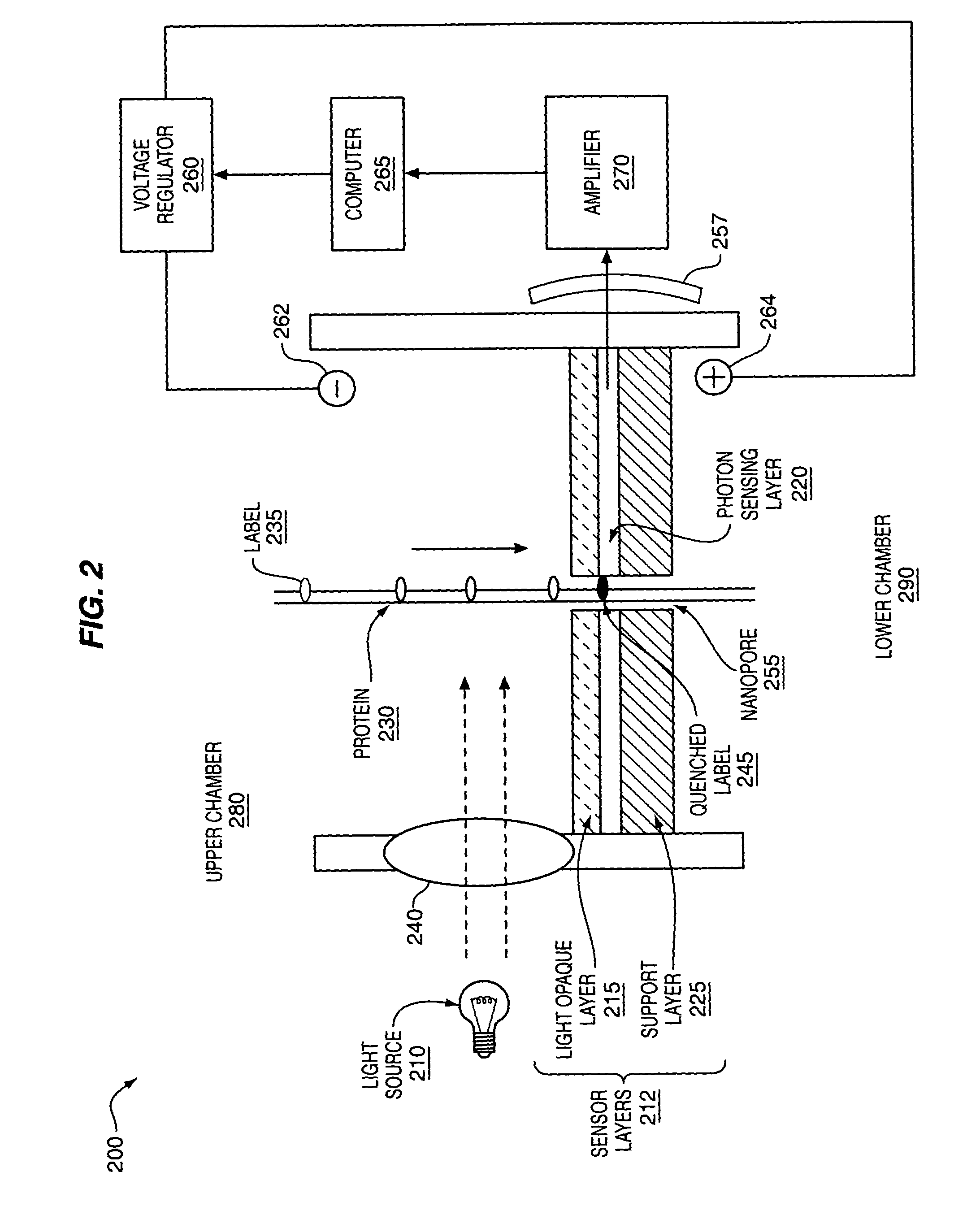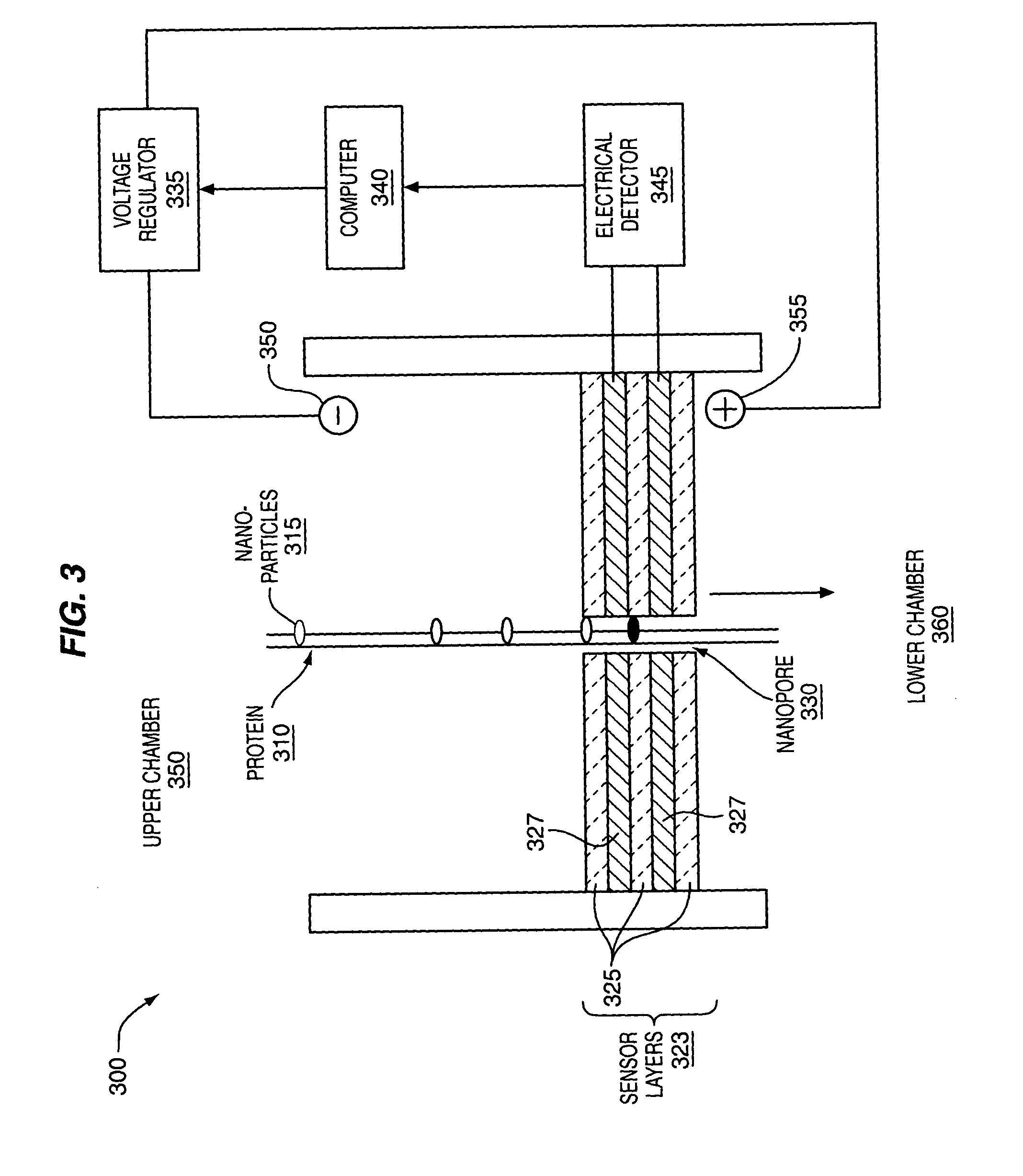Methods and device for analyte characterization
a technology of analytes and characterization methods, applied in the field of analyte analysis, can solve the problems of waste disposal problems, laborious, expensive, inefficient and time-consuming, and existing methods for protein sequencing based on the edman degradation techniqu
- Summary
- Abstract
- Description
- Claims
- Application Information
AI Technical Summary
Problems solved by technology
Method used
Image
Examples
example 1
Apparatus for Protein Identification and / or Sequencing
[0107]FIG. 2 and FIG. 3 provide non-limiting examples of methods and apparatus for protein 230, 310 analysis. An apparatus may comprise one or more sub-devices 200, 300. Each sub-device 200, 300 may comprise fluid filled first 280, 350 and second 290, 360 chambers, separated by sensor layers 212, 323. One or more nanopores 255, 330 may extend through the sensor layers 212, 323 and allow passage of labeled proteins 230, 310. The nanopores 255, 330 may be operably coupled to one or more detectors 257, 345 that can detect labeled amino acid residues 235, 245, 315 as they pass through the nanopores 255, 330. Electrodes 262, 264, 350, 355 in the first and second chambers 280, 350, 290, 360 may be used to generate an electrical field that drives labeled proteins 230, 310 from the first 280, 350 to the second chamber 290, 360 through the nanopores 255, 330. The electrical gradient may be controlled by a voltage regulator 260, 335, which...
example 2
Photodetection
[0116]As illustrated in FIG. 2, amino acid residues labeled with a photolabel 235 may be excited by a light source 210, such as a laser. Excitatory light may pass through a transparent window 240 in the first chamber 280, exciting the photolabel 235 to a higher energy state. The labeled amino acid passes through the light opaque layer 215, cutting off the source of excitatory light and shielding the photodetector 257 from the light source 210. As the photolabel 235 passes the photon sensing layer 220, it emits a photon and returns to an unexcited state 245. The emitted photon may be detected by a photodetector 257. The detected signal may be amplified by an amplifier 270 and stored and / or processed by a computer 265. The computer 265 may also record the time at which each labeled amino acid passes through the nanopore 255, allowing the calculation of distances between adjacent labeled amino acid residues and the compilation of a distance map for each type of labeled am...
example 3
Electrical Detection
[0118]As illustrated in FIG. 3, amino acid residues may be tagged with a label 315 that can be detected by its electrical properties. In one non-limiting example, the label 315 may comprise gold nanoparticles 315. As an amino acid residue attached to a gold nanoparticle 315 passes through a nanopore 330, it produces detectable changes in the conductivity, resistance and other electrical properties of the nanopore 330. The conducting layers 327 flanking a nanopore 330 may be operably coupled to an electrical detector 345, which may detect any type of electrical signal, such as voltage, conductance, resistance, capacitance, etc. The detector 345 may be operably coupled to a computer 340 to process and store data. Distance maps showing distances between labeled amino acid residues may be constructed and used to identify and / or sequence the labeled protein.
[0119]A nanopore 2 to 5 nm in diameter may provide fluid communication between the first 350 and second 360 cham...
PUM
| Property | Measurement | Unit |
|---|---|---|
| width | aaaaa | aaaaa |
| width | aaaaa | aaaaa |
| width | aaaaa | aaaaa |
Abstract
Description
Claims
Application Information
 Login to View More
Login to View More - R&D
- Intellectual Property
- Life Sciences
- Materials
- Tech Scout
- Unparalleled Data Quality
- Higher Quality Content
- 60% Fewer Hallucinations
Browse by: Latest US Patents, China's latest patents, Technical Efficacy Thesaurus, Application Domain, Technology Topic, Popular Technical Reports.
© 2025 PatSnap. All rights reserved.Legal|Privacy policy|Modern Slavery Act Transparency Statement|Sitemap|About US| Contact US: help@patsnap.com



